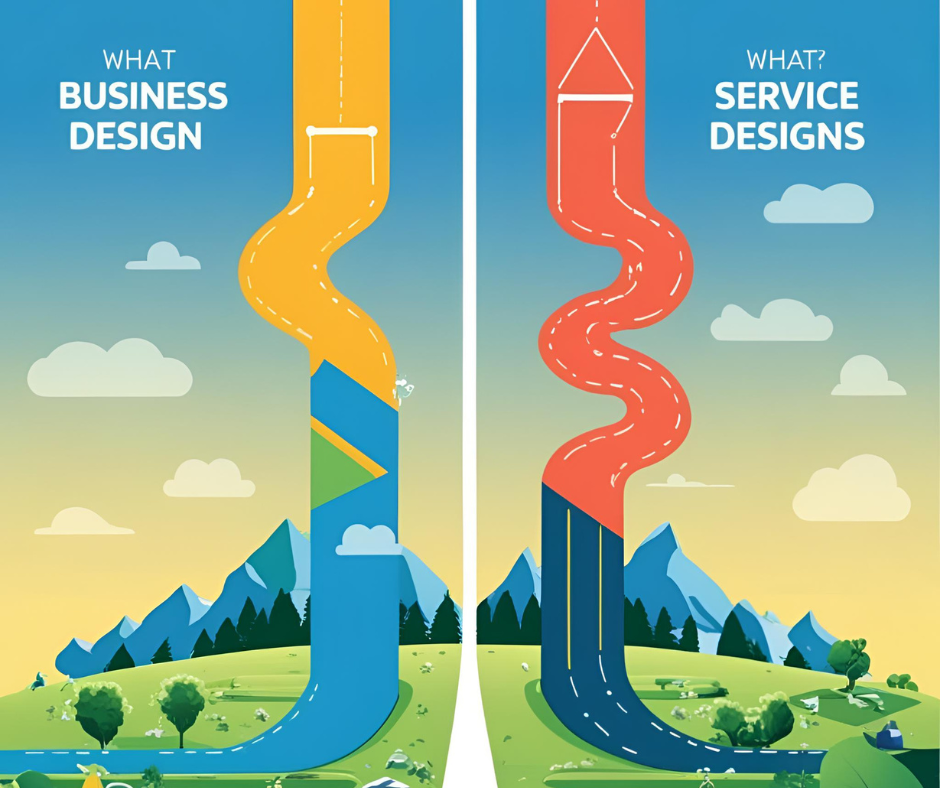Not long ago, I deeply conversed with fellow professionals from the tech and startup world. Amidst talk of scaling challenges and user experience design, two terms kept surfacing—Business Design and Service Design. It struck me how often these are confused or used interchangeably. Yet, they serve different purposes and require distinct mindsets.
That conversation inspired this guide. With over 15 years of experience in business strategy and digital marketing, I, Steven Sondang, have seen firsthand how a clear understanding of these two disciplines can be the difference between a thriving product and a failed one. Let’s break it down in a way that’s practical, professional, and easy to understand.
What Is Business Design?
Business Design is what happens when you blend creative thinking with commercial viability. It’s a strategic approach ensuring a great product or service isn’t just desirable but also feasible and profitable.
Business Designers are like architects of the business model. They assess whether each part of the model—from customer segments to revenue streams—aligns with the market’s needs and supports long-term sustainability.
What Is Service Design?
Where Business Design is about structure and viability, Service Design is about experience. It focuses on how users interact with a product or service, ensuring they are seamless, delightful, and human-centered.
The goal is to bridge the gap between customer expectations and what the business delivers. Service Designers craft user journeys, explore pain points, and identify opportunities for improvement across all touchpoints.
How Are They Different?
Business Design and Service Design draw from design thinking—empathy, prototyping, and iteration. However, they differ in what they prioritize, how they research, and what outcomes they aim for.
1. Goals and Success Metrics
- Service Design: Optimises for user satisfaction and engagement.
- Business Design: Optimises for profitability, scalability, and long-term value.
2. Research Approach
- Service Designers dive into human behavior. They conduct interviews, build personas, map emotional journeys, and study real-time interactions.
- Business Designers look at the broader market. They conduct desk research, study trends, analyze competitors, and project revenue scenarios.
3. Tools and Methodologies
- Service Design tools include Empathy Maps, Customer Journey Maps, Personas, and Service Blueprints.
- Business Design tools include Business Model Canvas, Value Proposition Canvas, SWOT Analysis, and Blue Ocean Strategy.
4. Deliverables
- Service Design: Journey maps, interface flows, wireframes, or service prototypes.
- Business Design: Business model projections, cost/revenue scenarios, and validation roadmaps.
5. Timeframe and Focus
- Service Design: Focuses on improvements to immediate to mid-term user experience.
- Business Design: Focuses on long-term strategic outcomes, growth, and market positioning.
Why Do People Confuse Them?
It’s understandable. Both disciplines embrace creativity and research. Both aim to create value. But they ask fundamentally different questions:
- Service Design asks: “How does the customer feel and behave when using this service?”
- Business Design asks: “Can we turn this solution into a profitable, scalable business?”
One looks inward at user interaction. The other looks outward at market and financial feasibility.
Lessons from the Field
In my consulting experience, I’ve seen products that offered delightful customer experiences but lacked a strong business model to sustain them. I’ve also seen technically sound businesses with little regard for user experience fall flat.
The sweet spot? Businesses that use both approaches.
Stronger Together: Why You Need Both
Think of it like building a house:
- Service Design ensures the house is liveable, comfortable, and user-friendly.
- Business Design ensures the house is structurally sound, efficient, and profitable to build.
The best businesses begin with understanding the user, then validate whether that solution can stand up financially and strategically.
Here’s a practical approach I often recommend:
- Start with Service Design to identify user problems and validate desirability.
- Follow with Business Design to validate feasibility, viability, and scalability.
This layered process helps you avoid the trap of building beautiful ideas with no path to profitability—or conversely, building businesses nobody actually wants.
Summary: Different Disciplines, Shared Purpose
To recap:
- Service Design = Creates memorable, meaningful customer experiences.
- Business Design = Creates viable, scalable business models.
- Service Designers measure success by user satisfaction and engagement.
- Business Designers measure success by growth and revenue.
Combined, they produce impactful, resilient businesses that delight users and generate long-term value.
About the Author: Steven Sondang
Steven Sondang is a seasoned Digital Marketer and Business Strategy Specialist with over 15 years of experience helping brands and startups across Southeast Asia grow. Known for bridging the gap between creativity and commercial outcomes, Steven specializes in transforming great ideas into sustainable business models.
Steven can help you align strategy, user experience, and market dynamics to drive real growth, whether you’re just launching or looking to evolve your business.
Ready to design a business that works for both your customers and your bottom line? Let’s talk.







